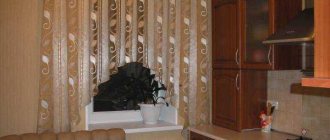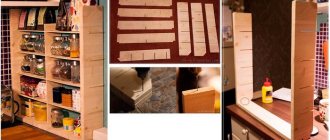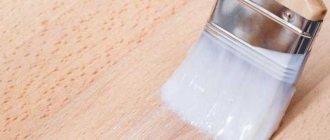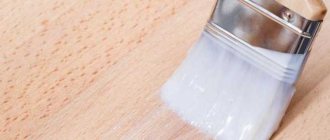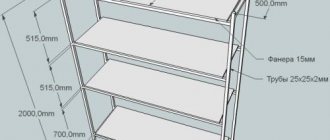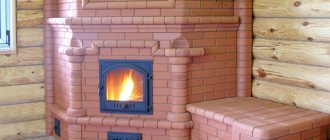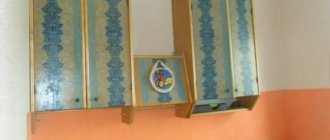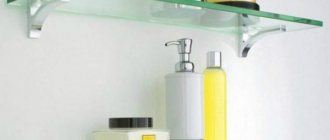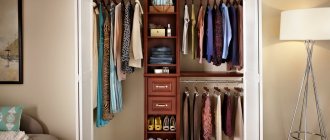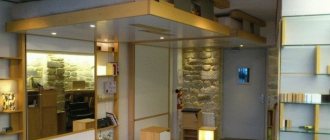Recently, when decorating a kitchen, designers are increasingly suggesting installing wall shelves, confidently declaring that this is a practical and interesting solution, and as evidence, they offer to look at photographic examples of completed projects. Owners of small-sized premises should especially listen to this opinion, completely replacing wall cabinets with shelves. This option is suitable for almost any style, from retro, oriental to modern minimalism and hi-tech. Today, material from the editors of Homius.ru will introduce you to the main nuances of choosing, manufacturing, assembling and purchasing shelves, and we will also provide a master class on making a simple wall structure for small items in the kitchen.
Interesting accessories are placed on open shelves
Features of kitchen design with shelves
Open shelves are full-fledged furniture. It is very comfortable and stylish. Allows you to organize the space and make it more full. Therefore, you should not classify this subject as secondary. Using products instead of bulky cabinets makes it possible to add zest to the interior, thanks to the open arrangement of cans, plates, pots, candles, boxes, and other things.
Kitchens with shelves look very spacious and visually appear larger. At the same time, all the necessary items are at hand. With the correct arrangement of utensils, the housewife’s love for systematization and order will be clearly visible; in any case, she will have to cultivate this quality in herself, since all the elements are in plain sight.
However, such decoration requires constant maintenance; dust settles on unprotected surfaces, which will be noticeable. Also, unpresentable items should not be displayed; they should be hidden or disposed of. For small rooms it will be very difficult to place everything you need on the shelves. If you increase their number, the room will become unnecessarily cluttered.
Processing shelves and side walls of the product
I carefully sanded the surface of the boards and battens with a coarse sanding pad. Then I eliminated the unevenness on the surface. To get a perfect finish, I used a fine grit sanding pad.
A hotel in England sheltered a man for free, and he repaid the kindness.
12 years ago, two young Belarusians won the Green Card lottery and moved to the USA
The son is handsome, and the daughter is a copy of her mother. Yulia Menshova showed photos of children
The boards were treated with acetone. After 2 hours I started assembling the shelves.
The side walls were boards measuring 117 x 15 cm. I used 3 wooden rectangles as shelves. Their dimensions are 60 x 13 cm. The rectangle left aside became the lower part of the product. Its size is 60 x 15 cm.
Types of kitchen shelves
Shelves are a very convenient item that allows you to rationally use space. They can be closed, represented by a standard cabinet, or open, in the form of a horizontal crossbar mounted on the wall. To achieve harmony in the kitchen, designers often combine both options. Also, based on appearance and installation method, the following types of products can be distinguished:
- Wall-mounted. These are the most common designs that are installed along a flat wall. Characterized by a variety of shapes and sizes. There are single- and multi-tiered models.
- Floor-standing. This is a transitional variety that can be called a shelving unit, an open cabinet. They are installed on the floor and are additionally fixed to the partition for stability.
- Floating. An open shelf attached to the wall that has no visible fasteners. They can be located along partitions, in the corner.
- Angular. This is the ideal solution for a small kitchen. They allow you to use free corners that are rarely used for any purpose.
- Glowing. This item will help transform your interior. In fact, by treating any surface with chemical compounds, you can achieve the desired effect. To create the effect, fluorescent liquids and luminol are used.
- With backlight. To do this, an LED strip is installed on the furniture. It is thin enough so it won't be noticeable.
- Hanging. Good models for large spaces. Using a rope, cable, or chain, they are fixed to the ceiling, wall beam, and can be located in any convenient place, pressed against the wall, or hanging over the island part of the kitchen area.
Types of wall shelves for the kitchen with photos in the interior
Wall shelves are a very convenient item, using which you can place many small things without cluttering the space of the room where they are placed. In addition, such items can serve as decorative elements that give the room a certain flavor and originality. Structurally, shelves placed in the kitchen can be of several types: open and closed, corner and cantilever, symmetrical or asymmetrical in shape, with built-in drawers and various additional decorative elements (lighting, inlay, etc.).
Open kitchen shelves
Open shelves are the most optimal in functionality and inexpensive option for such products, which are most accessible for making with your own hands from scrap materials.
A classic version of an open shelf, used in the kitchen of a country house and in a comfortable apartment
The convenience of using an open shelf is that in order to take an item placed on it (dishes, containers for storing spices or bulk products, etc.), you just need to reach out and take what you need.
In a modern kitchen, open shelves look stylish and are easy to use.
Fastening elements for open shelves can be hidden or be additional decorative elements of such structures. These can be brackets of various shapes and sizes or structural elements that combine all the components of the product into a single whole.
Open shelf made of artificial stone
The simplest option for self-production are products of this type, made from wood or panel materials (chipboard, MDF, etc.). This is due to the fact that wood is easy to process and has a low specific weight, which does not require the use of complex fastening elements when hanging on the wall.
Wood is an environmentally friendly material that can be used in various types of premises
In an open type design, several shelves can be combined, while the material used in manufacturing can be completely different.
Open shelves made of glass and metal look light without cluttering the interior of the kitchen
Closed wall kitchen shelves
A distinctive feature of closed shelves is the presence of rear and side walls, as well as doors of various designs (sliding, hinged, lifting).
Closed shelves can be decorative elements of the kitchen space and a place for placing kitchen utensils
The presence of doors allows you to store on such shelves sharp-smelling ingredients used during cooking (spices) and utensils used in everyday life.
Closed shelves with doors equipped with a lifting mechanism
When made with your own hands, these products are more complex, because... when assembling them, it is necessary to ensure reliable closing of the doors, and the product itself, as a rule, has more weight than open-type analogues.
Closed wall mounted shelf made of metal
For the manufacture of products of this type, various materials can also be used: wood and metal, glass and panel materials made from wood processing waste (chipboard, MDF, etc.), as well as durable plastic.
Wall shelf model PO-1200/400
Corner kitchen shelves
The corner structure can be open or closed; its distinctive feature is its placement on two walls located at a certain angle to each other.
Corner shelves are very functional, especially in small kitchens
The materials used in manufacturing can also be completely different, which allows you to choose a model in accordance with the design style of the kitchen space.
Open design is most often used in corner shelves
There can be a huge number of design options for corner shelves, so you can always find a model that satisfies the user with all the requirements placed on it.
Corner glass shelves
Decorative wall shelves for the kitchen
Decorative wall shelves serve to create coziness in the kitchen, giving it a certain style and flavor.
Using decorative shelves you can decorate your kitchen space in any style.
These are, as a rule, open-type shelves made of lightweight materials, because decorative items are also lightweight and there is no need to construct durable structures.
Utensils not used in everyday life can be placed on decorative shelves
It is quite possible to make decorative shelves yourself using available materials.
Decorative wooden shelves "Ferro Raffa"
Related article:
Wall mounted shelf : varieties, what materials they can be made from, photos of the product in different rooms, how to make it yourself and how to attach it correctly.
Materials - advantages and disadvantages
Shelves are a very popular element of furniture. It is difficult to find a material that could not be used for their production. Home craftsmen have been very successful in this matter, they use different approaches, making products from any available materials, for example, from old boxes, pallets, glass, plastic bottles, cans, slate, and other available things. The following types of raw materials are used in industrial production:
- tree;
- MDF and chipboard;
- metal;
- glass;
- plastic.
The purpose of the shelf and the style of its execution depend on the material. This circumstance is taken into account when choosing a finished product, which should fit harmoniously into the interior of the kitchen. In order to make the right decision and choose the most suitable option, we will consider in detail the main types of raw materials used.
Tree
Wooden shelves are suitable for almost all interior styles. Natural wood is a win-win option. Products made from this material are found in most kitchens. They can have a simple or complex shape, located horizontally, vertically, or in a corner. This raw material is easy to work with, so you can make a shelf with your own hands.
When choosing a product or producing it yourself, you first need to pay attention to the quality of the board. It must be perfectly smooth, without voids, cracks, chips, or knots. The most affordable items in terms of price and processing are made from coniferous wood: spruce, pine. Higher quality models that are strong and durable are made from oak, ash, and larch.
To attach wall shelves to a wooden surface, you can use self-tapping screws, to a brick surface - dowels, and to a concrete surface - anchor bolts.
The main advantages of open wooden structures include:
- Environmental friendliness. The raw materials do not emit harmful substances.
- Durability. With careful use, the wood will last for many years.
- Beautiful appearance. The presence of a natural pattern always looks original.
- Strength. The material is resistant to mechanical damage.
- Prestige. The interior with wooden furniture has a rich look.
Flaws:
- Fear of moisture. Without treatment with special water-repellent compounds, the wood may swell.
- Difficult care. Do not use detergents when cleaning.
- Does not tolerate direct sunlight well. Under their influence, the surface burns out.
- Absorbs odors.
MDF and chipboard
A cheaper option compared to solid wood are shelves made from MDF or chipboard. Both materials are made from sawdust, but the particle board is glued together using formaldehyde resins, so you need to choose a product with emission class E1 or E0. Let's consider each type of raw material separately.
- MDF. Literally, the abbreviation stands for finely dispersed fraction. It is made by pressing crushed chips at high pressure and temperature. The main advantages of the material include: environmental friendliness, ease of processing, aesthetics, and a wide selection of colors. Disadvantages include: high cost compared to chipboard, fear of moisture.
- Chipboard (chipboard). It is produced by pressing chips mixed with substances of non-mineral origin. If you use laminated chipboard, then in terms of external characteristics it is not inferior to MDF, and in the price category it is significantly superior. However, the raw material has limited moisture resistance, low strength, it is impossible to make figured cuts on it, it emits harmful substances.
Metal
This is the most durable material. The products are characterized by reliability. The structures are indispensable when arranging a durable stand for storing heavy objects. They are very convenient to use in places with high dust and humidity. They will be an excellent addition to both professional and individual kitchens.
Metal shelves go well with kitchen units that have metal elements on the façade. They allow you to stylishly decorate your interior. And if earlier the elements were associated with rough objects, now manufacturers produce thin-walled shelves characterized by graceful shapes.
Metal products are characterized by the following positive qualities:
- long service life;
- good strength;
- lightness, especially models made of aluminum;
- are not afraid of humidity and high temperatures.
Flaws:
- the item must be periodically painted to protect the surface from moisture;
- not suitable for all interiors;
- forged models have a very high cost;
- It is very difficult to make on your own; you will need a special tool, skills in working with a grinder and welding.
To avoid corrosion, do not skimp on paint. It is necessary to choose high-quality dyes intended for metal.
Glass
Glass products are more common in the bathroom. However, these models are very popular among many designers and ordinary people. The material is neutral to water and does not absorb odors. Glass does not visually clutter up the space, transmits light well, and gives any room airiness and lightness. The items look casual, so many people began to decorate small kitchens with them.
When choosing a suitable option, first of all you should pay attention to the corners; they should be rounded and smooth to the touch. Sharp edges will cause cuts when cleaning. Another important parameter is the thickness of the material; it should be at least 5 mm. The best option would be tempered glass and multilayer triplex, which are characterized by increased strength.
The main advantages of the shelves include:
- neutral to moisture;
- transparency;
- durability;
- large selection of shapes, unusual design;
- attractive look.
Flaws:
- fragility of most models;
- low load-bearing capacity;
- difficult to maintain, fingerprints remain on the surface;
- high cost of quality products;
- heavy weight.
Plastic
Along with other materials, plastic shelves are also in demand. They fit well into the interior of the room. Manufacturers produce different models that differ in design, appearance, color, and texture. However, they are presented mainly in multi-level options used for storing kitchen utensils and food.
Plastic models should not be hung above a stove or near heating appliances. The surface may become deformed when exposed to high temperatures. Also, they should not be overloaded with various heavy objects. When choosing, you should not give preference to cheap products; they quickly change their color. The ribbed surface is very difficult to clean.
A plastic item has certain advantages:
- affordable price;
- a light weight;
- neutral to moisture;
- large selection of shades and shapes;
- simple installation;
- easy care.
Flaws:
- fragility, fear of mechanical damage;
- low load-bearing capacity;
- harmful, releases harmful substances when heated;
- short service life.
Required materials and tools
- Board size 152 x 31 cm (suitable thickness).
- Reiki.
- Board size 122 x 31 cm (suitable thickness).
- Wood saw.
- Construction tape.
- Level.
- Pencil.
- Steel clamp 800 x 120 mm (or more).
- Wood glue.
- Electric drill.
- Hinges for frames.
- Dowels.
- Nails.
- Hammer.
- Coarse sanding sponge.
- Brush.
- Sanding sponge for fine polishing.
- Acrylic paint.
- Varnish for wood.
Shelves in different styles
Wall-mounted, tabletop, and floor-mounted storage structures should be in harmony with the overall style of the kitchen. They can be found in many designer interiors. Thanks to the variety of materials, shapes and designs, you can choose any successful combination with the set, surfaces and other elements. It is important to choose the right color, taking into account the purpose of the shelf, its location, and its perception under decorative lighting.
Provence style
Racks and shelves in the Provence style have an aged look, as if they have been hanging in the kitchen for several decades. Multiple cracks, irregularities, and roughness add credibility. They create the impression of last century design by processing materials using special techniques.
An ideal option for Provence is shelves made of natural wood. But due to the high cost, the natural beauty of wood is replaced with MDF and forged structures. The color of the racks should be in harmony with the furniture, textiles, and surfaces. It shouldn't be bright. Suitable beige, sand, coffee, pale pink.
In a Provence country kitchen, many items and accessories are in plain sight, so open shelves come in handy. All kinds of baskets, dishes, small decor and even pots are placed on them.
High-tech style
Modern cool high-tech or modern design accepts only practical materials. Shelves made of metal and glass will fit perfectly. If these are other materials, then they should be painted black, white, blue, gray and their shades. Suitable free-standing structures, on rails, suspended or floor-mounted. The main rule is nothing superfluous, only direct functional purpose.
Large iron racks can be used to store utensils. Household appliances, a TV, and a minimum number of decorative elements are placed on wide shelves. Designs must have clearly defined lines, no arched shape or rounded corners. They often have additional lighting installed.
Scandinavian style
The kitchen contains mainly natural materials. Wood is suitable for shelves. An excellent effect is achieved by combining open and closed shelving painted white. You can hide dishes and rarely used items behind the doors. Originally designed spice jars and glasses are on display.
The shelves should be spacious. The simultaneous presence of functional items and decorative elements is not allowed. The main purpose of shelves in a Scandinavian-style kitchen is to emphasize stylistic direction. The following items will help to successfully highlight the original design:
- Photographs, paintings, drawings of animals, sea, nature;
- Green indoor plants (potted flowers, ornamental grass);
- Natural stones, straight candles;
- Volumetric letters (arbitrary or forming inscriptions);
- Books with culinary recipes, magazines.
Loft style
The attic style accepts massive shelves made of a wide variety of materials. The main thing is to follow one direction with the overall interior. Typically, loft kitchens are spacious and bright, so long single shelves made of wood, corner brick structures, stainless steel linings on protruding pipes and other communication details will look great.
The wall in the dining area can be decorated with shelves made from inverted plywood boxes, or shelving resting on a concrete wall. Despite the strength and large mass of the structures, they do not convey a functional message. The main emphasis is placed on industrial accents.
Design Features
Before you hang shelves in the kitchen, or even make them in general, you need to decide on their appearance. It will directly depend on the existing kitchen interior.
Both wooden and plastic boards and simple pallets can serve as the basis for the structure. The proposed instructions will tell you which type of structure is suitable for a particular style.
- Minimalism and hi-tech . In this case, designs with simple, laconic forms will be most appropriate. The color scheme is monochromatic, but sometimes it is acceptable to use bright shades. As an addition, a DIY kitchen shelf can be decorated with LED lighting.
Minimalism and hi-tech are characterized by a simple and laconic design.
- Loft or Scandinavian . Massive shelves with a slightly rough texture are perfect. The basis for them can be chipboard sheets, rough boards, old pallets and boxes.
The more original the materials, the better they will fit into the loft interior or Scandinavian decor
- Modern . Glass or metal accessories will ideally complement the Art Nouveau style.
Metal fasteners are what you need for modern style
- Country, Provence and shabby chic . Decorative shelves with metal consoles, patina, decoupage patterns or carvings as decoration will succinctly fit into such an interior.
The best shelf for a kitchen in a country or shabby chic style is a design made of natural wood
- Modern . To fill it, you can use unusual grid shelves, racks for wine bottles made of cork, etc.
Shelf stairs fit perfectly into modern decor
Ideas and options for arranging shelves in the kitchen
Open kitchen shelves will never lose their practical value. An excellent decorative element can be made in any style. Original interior decoration is an ideal solution for a small kitchen. By choosing a good location, you can use them to increase the space, hide finishing imperfections, and create a cozy atmosphere. The shelves must be carefully integrated into the set so that symmetry is not broken.
Using corner shelves
Ideal for saving space. You can use a lot of ideas for their successful location. An interesting option for a small room is shelves under the ceiling. Wooden crossbars in the corner will look like decorative beams, while at the same time fulfilling their intended purpose.
Corner structures can be attached to the outermost drawer of the set and frequently used items can be placed on them. These can be glasses, containers with spices, cookbooks. By decorating them with lighting, you can highlight a corner when the lights are off and create an atmosphere of comfort and tranquility.
“Floating shelves” add airiness to the kitchen. A wide base will allow you to unload the closed storage area, taking on part of this function. The design and materials can be anything.
Shelves for flowers
Place such stands as close to the window as possible, since plants need light. The dimensions and features of the shelves will depend on the number of colors and their type. Designs can be wall or floor, single or multi-seat.
Small pots can be placed on corner shelves; for lovers of climbing plants, ceiling-mounted options are more suitable. If space in the kitchen allows, floor shelving would be an excellent arrangement. You can place large pots with mature flowers on the lower tiers, and decorate the upper ones with small-leaved and lush bushes.
Narrow shelves made of lightweight plastic will look good on the windowsill. Also, glass shelves on suction cups with violets and decorative grass will fit into the window space. The structures reinforced at the base can support up to 10 small pots and one medium flower.
Wine shelves
For storing wine at home, many systems have been developed that meet all requirements. In addition to decorative functions, bottle shelves must fulfill their intended purpose - to preserve the taste of a noble drink.
Incorrect placement of wine racks can negatively affect the color and consistency of drinks. The main factors that can spoil the contents of bottles are direct sunlight, excessive humidity, high temperature, vibration. When choosing a place in the kitchen for a wine rack, you need to take into account not only the design of the room and personal preferences. The type of construction and the way the bottles are placed are important. The safety of the product will be ensured by the following options:
- Vertical shelf for 5-10 bottles. The design is ideal for small kitchens. The extended strip is mounted vertically to the wall. The wine is placed in the neck holes in a checkerboard pattern;
- Horizontal suspended structures. Semi-closed boxes are also attached to the wall. The bottles are placed in a row; at the bottom you can make rails for storing glasses;
- Diagonal. The bottles are placed by grade in certain cells. This allows you to create optimal storage conditions;
- Inclined. Universal designs for simultaneous storage of wines in a convenient position and glasses;
- Presentation. Suitable for large kitchens. A simultaneous combination of large inclined racks and horizontal pull-out shelves.
Shelves under the windowsill
In small kitchens there is always not enough space to store household items. The space under the window sill often remains empty. If the battery is not hidden there and important communications do not pass through, this place can be allocated for organizing convenient shelves.
The size of the structure will determine the height and depth of the window sill. The material and design style must match the overall decoration of the room, then the original shelves will seem like part of the set. You can place dishes, winter preparations and other items that do not have specific storage requirements under the windowsill. It is necessary to take into account the peculiarity of a dark place. Live plants and decorative elements are not placed on grounded shelves.
Shelves on the countertop
They will make the kitchen tidy and the countertops clean and spacious. Usually these are multi-tiered structures with narrow shelves. They can accommodate many useful little things (salt shaker, napkin holder, knife stand and other items).
Shelves on several floors can have different shapes and features. The choice of the most convenient option will depend on the location of the table, the design of the apron, and the presence of hanging structures.
Railings with hanging shelves
A practical, fashionable solution for the kitchen. The structures look light and airy, but at the same time very strong and reliable. A variety of shapes and sizes allows you to choose a suitable railing design with hanging shelves.
More often you can find hooks on the railing. They hold objects with handles, potholders, scissors and other household items. If there is no need for a large number of such items, the structure can be used to install shelves and expand their functionality.
Before choosing a shelf, you need to decide on its purpose. It is important to immediately indicate the approximate weight of items for future storage and dimensions. You should also take into account the weight of the product itself and the presence of sides. Railing shelves can have a variety of shapes. They can be hung in a corner, above a countertop or sink.
How to make shelves for the kitchen with your own hands
Original DIY wooden kitchen shelves will decorate the interior and become an important multifunctional detail. Unlike cheap options from a furniture store that have dubious aesthetic value, homemade ones are almost guaranteed to turn out beautiful if you take the problem seriously. You can design them in your home workshop yourself or using drawings or drawings from the Internet.
If this is your first experience of this type of activity, then it is better to start with something simpler.
Necessary tools, material
When making shelves, it is permissible to use almost any materials:
- natural wood is an environmentally friendly material that always looks good. The most commonly used species are pine, oak, birch, cedar, spruce, linden, larch, yew, ash, beech, hornbeam, maple, alder, and walnut. The shelves come out different in color, weight, texture. They are easy to restore, decorate with patterns and artistic carvings;
- metal - it produces durable, thin, elegant, stylish structures that can withstand significant weight. The material used is stainless steel, less often aluminum, and individual elements made of cast iron. Shelves for dishes placed above the sink are made of mesh so that water from cutlery can easily flow down;
- plastic is the most economical, cheapest option. Plastic products are made in various colors, they are easy to wash and, if necessary, disassemble. They are often hung above the sink or countertop;
- MDF, chipboard, plywood - they resemble wood in appearance, but cost less. Such options are suitable for decorating modern interiors;
- Tempered glass – suitable for decorating a light, air-filled interior. The products will have to be washed frequently - fingerprints will always remain on them. The shelves are durable; hidden fasteners are preferable for them;
- plasterboard - items are made in different shapes and thicknesses. The design is complemented by LED bulbs, suitable for placing light decor. For kitchen areas, waterproof plasterboard is preferable.
You can make a shelf from chipboard, plastic panels or plasterboard.
Wooden shelves are most often made at home - for the job you will need a jigsaw, a screwdriver, a hammer drill, a grinder, a hammer, a pencil and a square for marking, a level, brackets or consoles for hanging, wide boards, stain, furniture varnish, screws, hardware, a brush , decor.
Using a hacksaw, you need to cut the boards (chipboard, plywood), and then properly sand the resulting parts.
Tip: if you plan to decorate the shelf with lighting, the connection location for light bulbs and LED strips should be planned in advance.
Manufacturing process
Instructions for making homemade shelves look like this:
- First, the design, product configuration, number of elements, and their location are thought through;
- a drawing of shelves and a sketch of placement in the kitchen space are made;
- boards intended for production are marked, cut to the intended shape, sanded - it is permissible to use only dry material that does not have falling knots;
- to prevent objects from falling, small sides are installed on the front and side parts of the structure;
- consoles and brackets are chosen smaller than the distance between the shelves;
- open ends are decorated with veneer and special decorative tape;
- Varnish, paint, and hand painting are applied to the wooden surface.
The color of the shelf should be selected based on the overall style of the kitchen.
The final stage of manufacturing is installation to the wall. Even a novice master can handle the installation of the structure. The wall is marked, holes are drilled for dowels, the shelf is secured with self-tapping screws, and its horizontalness is checked with a building level and plumb line. Shelves are made from MDF or chipboard in much the same way.
Fastening methods depend on the expected load and wall material.
To make a plasterboard product, you need plasterboard, aluminum profiles, perforated corners, wooden blocks, screws, dowels, mounting tape, wall fasteners, plasterboard putty, paint, self-adhesive film or wallpaper, lighting elements. After creating sketches and drawings, the material and the wall itself are marked. A frame of metal profiles is mounted on the latter, and plasterboard parts are secured. All surfaces are carefully puttied, sanded with sandpaper, primed, painted or covered with decorative self-adhesive film. If possible, the backlight is mounted so that the wires are not visible.
When starting to make furniture, albeit simple, but still, you need to first of all think about how it will fit with the surrounding environment.
Decorative lighting for shelves
Properly selected decorative lighting should naturally fit into the interior of the room and complement it. Its main feature is that they try to hide the light source. The main function is to focus on the expressive lines and beauty of the shelves. In addition, their contents will be clearly visible; finding the desired item will not be difficult due to lack of light. You can organize lighting using:
- Spotlights. They perform not only a decorative function, but also allow you to organize local lighting and illuminate the work area.
- LED clips. Allows you to organize the illumination of glass shelves. They are small in size and do not interfere with located objects.
- LED strip. It is very thin and, if installed correctly, will be invisible. Using the controller, the brightness of the diodes is adjusted separately for each color.
Product assembly
I applied glue to the edges of the first shelf and joined the board to the sides.
A steel clamp was used as a barrier. This tool prevented the boards from slipping out during installation.
I repeated the action 3 more times. The size of the gaps between the boards depended on the size of the items that would be stored on the shelves.
A designer friend told me the basic rules for choosing beautiful curtains for your home
I turn popsicle sticks into convenient toaster tongs: the technology is very simple
The taste of rhubarb and meringue pie is impossible to forget: the sourness makes it special
It is worth noting that this characteristic is individual for each specific case. The height of my first shelf is 40 cm, the second is 32 cm. This is a place to store large plates. The height of the third shelf is 25 cm, the fourth - 20 cm. This is a place to store coffee service and small plates.
I finished the job of installing the shelves to the desired height. Then I applied glue to the ends of the slats and attached the wooden strips to the product as shown in the photo.
They are needed to prevent plates from falling off the shelves.
Options for making shelves yourself
When making shelves independently, they mainly use materials that can be processed, which include wood, MDF, and chipboard. To work with metal, glass, stone, you will need special tools and equipment, as well as skills in handling them. Quite often they use improvised materials, for example, skateboards, chair backs, pallets, and old furniture.
The simplest one-level model can be made from a board and rope. It is enough to select the board of the desired width, drill four holes along the edges, pass a thick rope through them and secure it to the wall. Of course, you will first need to smooth out the corners, level the surface, treat the product with moisture-repellent agents, paint, and varnish.
You can independently make multi-level, roll-out structures on wheels, make corner options, floating models, panels from shelves. It all depends on the author's intention. They can be given an original shape in the form of various geometric shapes, animals, and abstractions. You need to paint homemade shelves in a color that matches the interior and additionally decorate them.
Preparing the side parts of the product
Inexpensive lumber is needed to create decorative shelves. I used boards I found in our shed. I needed to determine what size the decorative shelves should be. The dimensions had to correspond to the objects on them.
The hunter experienced the most exciting journey at the age of 92: he got lost in the forest
The Voice of War and Victory: how did Levitan’s great-grandson grow up and did he follow in his footsteps?
Dream catch: a man was able to pull out a huge carp while fishing (photo)
I needed furniture to store cutting boards and large plates. To make the larger shelves, I took some boards from the barn. The size of one of them is 152 x 31 cm.
Using a hacksaw and a construction tape, I cut a rectangle 117 cm long from this board. The width of a piece of wood is 31 cm. Then I cut this rectangle into 2 equal parts. I received two side parts of the shelf measuring 117 x 15 cm. Actual dimensions may differ from the figures I indicated by 5-6 mm.
Care: about cleanliness and how to avoid clutter on shelves
The kitchen is cleaned much more often than other rooms. This is due to the specifics of the room. You can reduce the amount of general cleaning to simply maintaining order if you properly organize your storage system. Proper placement of shelves and racks minimizes contamination of surfaces and decorative items.
It is necessary to responsibly approach the issue of choosing material and color for shelves. Glossy dark surfaces get dirty faster and stains remain on them. If you don’t want to rub them until they shine every day, it’s better to avoid this option. Hanging shelves and floor racks must meet the following requirements:
- Not afraid of moisture and contact with chemical cleaning agents;
- Easy to clean without prior dismantling;
- Be spacious and fit for purpose.
To avoid clutter in the kitchen, it is necessary to promptly review the contents of the shelves and remove unused items. Every thing should have its place. If the rack is intended for decoration or plants, there will be no place for a dirty forgotten spoon or a roll of paper towels.
Using corner shelves
In addition to using such a place to install vases and other similar items that decorate the interior, people use similar devices to place important and necessary things.
Many people in their home have a hand-made corner shelf for icons. This can be seen in houses in rural areas: in villages, hamlets.
People living in city apartments, cottages, and country houses prefer to use corner shelves for other purposes: on walls in corridors, in bathrooms.
At the dacha, it would be practical to make a corner shelf in the bathhouse with your own hands to place washing supplies.
- Beautiful DIY lampshade - simple ideas for making stylish design options for table lamps and floor lamps
- Do-it-yourself upholstery of a chair - methods of using upholstery and a review of the best materials (85 photo ideas)
Making a kitchen table with your own hands - step-by-step instructions for building a beautiful and durable table (115 photos)
